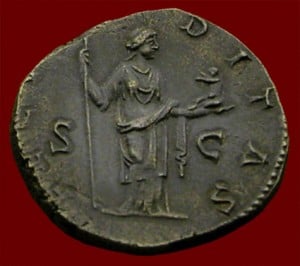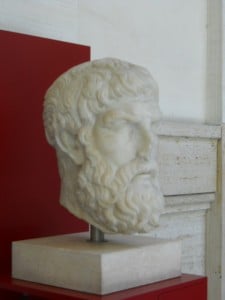On 10 May, and again on 31 May, the Roman legions at Duro Europa celebrated the Rosalia. This again connects the flowers of Spring with rituals for the dead, only this time the rituals were performed by military units for their fallen comrades rather than for family members. We learn of this celebration first with a military calendar from Syria. We do not know if the Rosalia was celebrated on the same dates by other legions throughout the Roman Empire, but we hear descriptions of the Rosalia in other texts suggesting that the Rosalia was common in the Roman army. Since the military calendar differs from other Roman calendars, it is possible that it represents a standard used among all legions. Then again each legion may have had its own schedule of festivals. However, since the month of May was dedicated to the dead, with Lemuria, it would seem reasonable that a military equivalent fell within the same month.

At the center of every Roman military camp there was a small shrine, the saculum. Inside this shrine the military standards were kept; these were the legion’s eagle and other standards for the maniples, cohorts, or vexilia. As with Roman temples, an altar was placed in front of the sacullum. At Rosalia the standards were brought forth and placed around the altar. They were crowned with wreaths of roses and a supplication, or thanksgiving, was performed before them. Beyond that one detail, nothing else is certain about this military ritual. But from its nature we can surmise something of its intent.

When someone died far from home, whether while serving in the army or away at sea, and thus was unable to be buried by his family, a cenotaphium would be erected as a dwelling place for his soul. His Lar was called three times and invited to enter the cenotaphium. For example, when Aeneas meets his deceased friend Deiphobus in the Underworld, he says, “Then I myself on the Rhoetean shore erected a hollow tomb, and with loud voice thrice called upon thy spirit (Virgil, Aeneid 6.505-506).”
An impressive cenotaphium, standing nearly 74 feet high, is the Tropaeum Traiani at Adamclisi, Romania. There are three monuments at the site. The oldest is a shrine bearing the names of three-thousand soldiers who had died in battle, probably from Legio XX Apollinaris that fought in the campaign of M. Cornelius Nigrinus in 86 CE. Nearby is a funerary tumulus over what was once a mass grave of the fallen soldiers. These may have instead been from another unit, Legio XXI Rapax, which was defeated by the Dacians in the same vicinity in 92 CE. Trajan avenged that defeat in 102 CE at the Battle of Tapae. He then erected the cenotaphium, seen below, that is thought to be for Cornelius Fuscus, the commander of the legion, whose actual grave lies further north across the Danube. Trajan dedicated the tropaeum to Mars the Avenger and decorated it with battle scenes and images of Dacian prisoners. The standard bearers seen above is one of 54 metopes that once decorated the tropaeum. Today 48 are housed in a nearby museum, while one is in Istanbul. Seen below is a reconstruction of the Tropaeum Traiani that was erected by the Romanian government in 1977.

On the Nones (7 May) the tombs of ancestors were decorated with wreaths of roses. With their red hues, the roses were offered to the dead as a gesture of reviving them, or at least of remembering how they were once while still alive. The red roses were the flowers of Venus, and they were a reminder of the Garden of Venus where the souls of the dead, as animae, would dwell as Her children, like little cupids living in the Blessed Isles. So offering roses to the Manes was a way of wishing their safe journey on to the Garden of Venus.
There is not much doubt that the Rosalia was intended to honor the military dead. The standards were being adorned with roses in the same manner as tombs and cenotaphs. With the Romans I think you would also have to consider that they thought of the standards as cenotaphia that carried the Lares of the legion, who were the spirits of their fellow soldiers, into battle with them. This would also explain why the loss of the eagles would be taken as such a tragedy by Romans. Perhaps it also explains why the second century Christian writer Tertullian criticized this veneration of the standards. The Rosalia was continued, however, even after the Roman army adopted Christianity. Something of the Rosalia remains even today in the parading of the colors of modern armies, where they are decorated with battle ribbons to commemorate where a unit has fought, as well as all the men who have served and died with the unit in the past. Laying a wreath of roses on the Tomb of the Unknown Soldier on Memorial Day is an echo of the Rosalia once performed by Roman legions.















